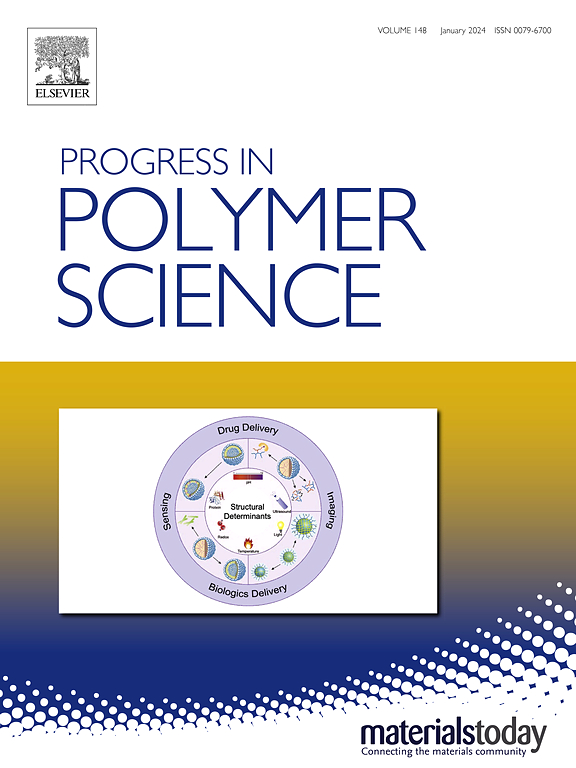室温下的非异氰酸酯聚氨酯-梦想成为现实
IF 26.1
1区 化学
Q1 POLYMER SCIENCE
引用次数: 0
摘要
聚氨酯(pu)是世界上应用最广泛的聚合物之一。然而,它们的传统生产依赖于有毒和危险的异氰酸酯化合物,其使用受到最近法规的限制。这推动了新的化学策略的发展,以获得非异氰酸酯pu,或nipu。由于异氰酸酯的高反应性,传统的PU合成通常在室温下进行,而NIPU合成通常需要提高温度以超过前驱体的低反应性。考虑到社会需求和监管变化,在r.T实现NIPU合成可以减少该过程的能源足迹,促进在现有PU制造设施和消费级应用中过渡到NIPU -从PU到NIPU的更无缝切换。此外,r.T反应对于最小化副反应和实现更广泛的官能团耐受性是理想的。这篇综述收集了未经桥接的数据和旨在实现在rt合成NIPU的最新策略。这包括单体设计、催化和rt高效杂化化学的使用方面的进展。各种聚合技术从广泛的多样性的前体进行了讨论,以及每个方法的优点和局限性。本文章由计算机程序翻译,如有差异,请以英文原文为准。


Non-isocyanate polyurethanes at room temperature – a dream becoming reality
Polyurethanes (PUs) are one of the most widely utilized classes of polymers worldwide. However, their conventional production relies on toxic and hazardous isocyanate compounds whose usage is being limited by recent regulations. This has driven the development of new chemical strategies to access non-isocyanate PUs, or NIPUs. While the traditional PU synthesis typically occurs at room temperature (r.T) due to the high reactivity of isocyanates, NIPU synthesis generally requires elevated temperatures to surpass the low reactivity of the precursors. Considering societal needs and regulatory changes, achieving NIPU synthesis at r.T could reduce the energy footprint of the process, facilitate transition to NIPUs within existing PU manufacturing facilities and in consumer-grade applications – a more seamless switch from PUs to NIPUs. Additionally, r.T reactions are desirable for minimizing side reactions and enabling a wider functional group tolerance. This review critically gathers unbridged data and recent strategies aimed at achieving NIPU synthesis at r.T. This includes advances in monomer design, catalysis, and the use of r.T-efficient hybrid chemistries. Various polymerization techniques from a wide diversity of precursors are discussed, along with the advantages and limitations of each approach.
求助全文
通过发布文献求助,成功后即可免费获取论文全文。
去求助
来源期刊

Progress in Polymer Science
化学-高分子科学
CiteScore
48.70
自引率
1.10%
发文量
54
审稿时长
38 days
期刊介绍:
Progress in Polymer Science is a journal that publishes state-of-the-art overview articles in the field of polymer science and engineering. These articles are written by internationally recognized authorities in the discipline, making it a valuable resource for staying up-to-date with the latest developments in this rapidly growing field.
The journal serves as a link between original articles, innovations published in patents, and the most current knowledge of technology. It covers a wide range of topics within the traditional fields of polymer science, including chemistry, physics, and engineering involving polymers. Additionally, it explores interdisciplinary developing fields such as functional and specialty polymers, biomaterials, polymers in drug delivery, polymers in electronic applications, composites, conducting polymers, liquid crystalline materials, and the interphases between polymers and ceramics. The journal also highlights new fabrication techniques that are making significant contributions to the field.
The subject areas covered by Progress in Polymer Science include biomaterials, materials chemistry, organic chemistry, polymers and plastics, surfaces, coatings and films, and nanotechnology. The journal is indexed and abstracted in various databases, including Materials Science Citation Index, Chemical Abstracts, Engineering Index, Current Contents, FIZ Karlsruhe, Scopus, and INSPEC.
 求助内容:
求助内容: 应助结果提醒方式:
应助结果提醒方式:


